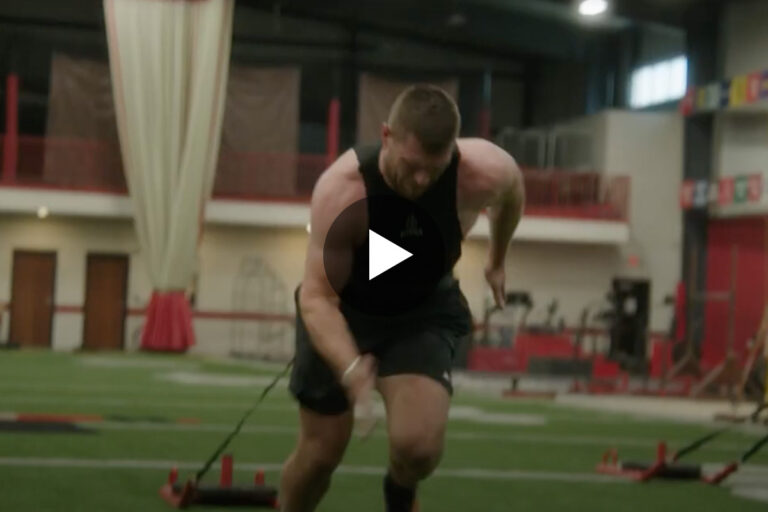Imagine being able to train for your favorite sport without leaving the comfort of your own home, or even your bedroom. By using visualization techniques as part of your training regimen, you can do just that. Research has shown that it’s possible for people to gain strength by using only their minds, and brain studies have revealed that thoughts produce the same mental instructions as actions.
Elite athletes ranging from tennis stars to golf legends, boxers to basketball players, and skiers to soccer players have been using visualization techniques since the 1960s. These mental practices have been found to enhance motivation, increase confidence, improve motor performance, and prepare your brain for success.
What Is Visualization?
Visualization or mental imagery is the process of creating a mental image of what you want to happen. So, let’s say that you’re a golfer who has a big tournament coming up. By visualizing your swing in your mind with the different clubs that you’ll be using prior to the tournament, and seeing yourself hit the exact shots that you want to, you’ll have a better chance of doing just that when the time comes.
The more detailed your mental imagery is, the better chance of success you’ll have. So, maybe before the match, you’ll visualize all 18 holes and play out what will happen in your mind. By seeing your entire match unfold in your head, you’ll know exactly how to approach each situation that pops up. For example, if you were to miss the fairway on the fourth hole and end up in the rough, how would you approach your next shot? Then visualize that shot so you’ll be prepared for it come tournament time. Or maybe you’ve already played the course and missed a putt on the seventh hole. Play that putt over in your mind, but this time, read the putt again and make adjustments to sink it. By seeing yourself make the putts and shots in your mind, you’ll know it’s possible for you to do just that when the pressure is on.
This way when the tournament comes around and you’re approaching the 18th green needing a perfect chip to keep you in contention, you can visualize your swing and see the ball landing exactly where you want it to go on the green before it happens. This will give you the confidence to step up and hit your shot.
Why Is Visualization Important For Athletes?
“Imagery is used by virtually all great athletes and research has shown that, when combined with actual practice, improves performance more than practice alone,” according to Psychology Today. “Imagery also isn’t just a mental experience that occurs in your head, but rather impacts you in every way: psychologically, emotionally, physically, technically, and tactically. Think of mental imagery as weight lifting for the mind.”
By engaging in a consistent visualization or mental imagery program, in addition to physical training, you know that you’re doing everything in your power to set yourself up to achieve your athletic goals.
“Visualization is one of the primary technologies used in sports psychology,” writes Matt Neason in a Sports Psychology Today article. “I’m a big believer in the phrase, ‘What happens out there is a result of what happens in here.’ In simple terms, this means your performance is often the result of what’s happening inside your head, or more specifically the movies and soundtracks playing inside your head.”
How Can You Implement Visualization Into Your Training Regimen?
Like any other skill, visualization requires time, energy, and effort in order to get better at it. If you’re not quite as successful at visualization or mental imagery as you’d like to be the first few times you try it, that’s perfectly normal. Were you able to throw a 50-yard pass the first time you picked up a football? Chances are you weren’t. The key is to create a consistent practice that you’ll be able to develop and improve upon over time.
Step 1: Set A Specific Goal For Yourself And Use All Your Senses
Before you begin your visualization, it’s important to have a specific goal in mind. These goals can be technical, tactical, mental, or overall performance related. Maybe it’s winning the championship and becoming the Most Valuable Player. Now, imagine yourself accomplishing that goal in the future.
“Hold a mental ‘picture’ of it as if it were occurring to you right at that moment,” according to Psychology Today. “Imagine the scene in as much detail as possible. Engage as many of the five senses as you can in your visualization. Who are you with? Which emotions are you feeling right now? What are you wearing? Is there a smell in the air? What do you hear? What is your environment? Sit with a straight spine when you do this.”
You may experience some difficultly practicing mental imagery at first, but the key is to continue showing up and trying. Eventually, you’ll be able to see, feel, hear, smell, and taste victory.
Step 2: Understand And Get Comfortable With Your Imagery Perspective
Imagery Perspective refers to what you’re seeing when you create your mental imagery. An internal perspective involves seeing yourself from inside your body and looking out, while an external perspective involves seeing yourself from outside of your body like on a video.
Research has shown that both perspectives are equally effective so whichever perspective you’re most comfortable with, stick with that. Then after you’ve successfully practiced visualization for a while you can try the other perspective and see if it helps you in a different way.
It’s also important to practice your visualizations in realistic conditions. If you’ll be playing a championship football game in cold weather with the forecast showing a possible snowstorm, make sure to incorporate that into your visualization. Don’t just pretend it’s sunny and 75 degrees outside during the championship game. The closer you’re able to get to the reality of your future situation, the better off you’ll be when the actual moment comes.
Step 3: Visualize Your Desired Result
“The problem with most people is that they program their subconscious mind with negative coordinates,” according to Sports Psychology Today. “They visualize images of failure, they replay mistakes, they think about negative scenarios that might happen, and picture the negative consequences that may arise. Unfortunately the subconscious mind doesn’t judge. It doesn’t say, ‘those coordinates are negative so I’ll just ignore them.’”
If you find that you’re mostly replaying negative scenarios in your mind at first, that’s OK. Since you’re creating the images, you can also edit them – switch the negative images with positive ones. For example, if you’re a baseball player and you see yourself making an error, instead of continuing on from there, stop yourself and make sure that you field the ball cleanly, successfully complete the play, and then move on.
You can also consciously flip the script and embrace your negative images, ultimately using them to your advantage. Think of the absolute worst thing that can happen and then experience that. Was that particular outcome as bad as you expected? Did the world stop because you missed that shot? By sitting with the negative images, you’ll realize that you’ll still be fine in the long run, even if you had one bad game. Then use that to your advantage and be confident in your performance.
Since you’re the one who controls the images being played in your mind, you can choose to see either negative or positive ones. They key is to turn the negative ones into positives, or get better at picking the positive images over time. This will allow you to go after and achieve your desired result.
Step 4: Create An Imagery Session Routine
Sure, it’d be great if you could just dial up the perfect visualization on command out of nowhere, but if you’re like most of us, you’ll have to work at mental imagery. Create a routine for yourself that you know you’ll be able to stick with and set aside time a few days each week that’s just for your visualizations. Some of you may prefer to practice mental imagery in the morning before your day gets going, while others may rather do visualizations at night. The time of the day isn’t what’s important, it’s that you’re actually committed to practicing your visualizations.
And remember that you don’t need to do the entire visualization all at once, or every day. It’s actually better if you don’t do visualizations every day, especially when you’re starting out, since that can lead to burnout. Your visualization sessions should be about 10 minutes long at first.
Step 5: Start A Visualization Journal
It may be difficult for you to track your progress without a way to see concrete results. By starting a visualization journal, you’ll be able to see your gains right there in front of you. You’ll be able to monitor the quality of your mental imagery, the length of your sessions, and any feelings that you experience during your session – positive or negative.
You can also keep a running list of mental imagery that you’d like to add to your future visualizations. Then do your best to incorporate those images into your next visualization session. You can also write daily affirmations like ‘I am a strong, powerful, and talented athlete’ in journal in order to stay positive.













